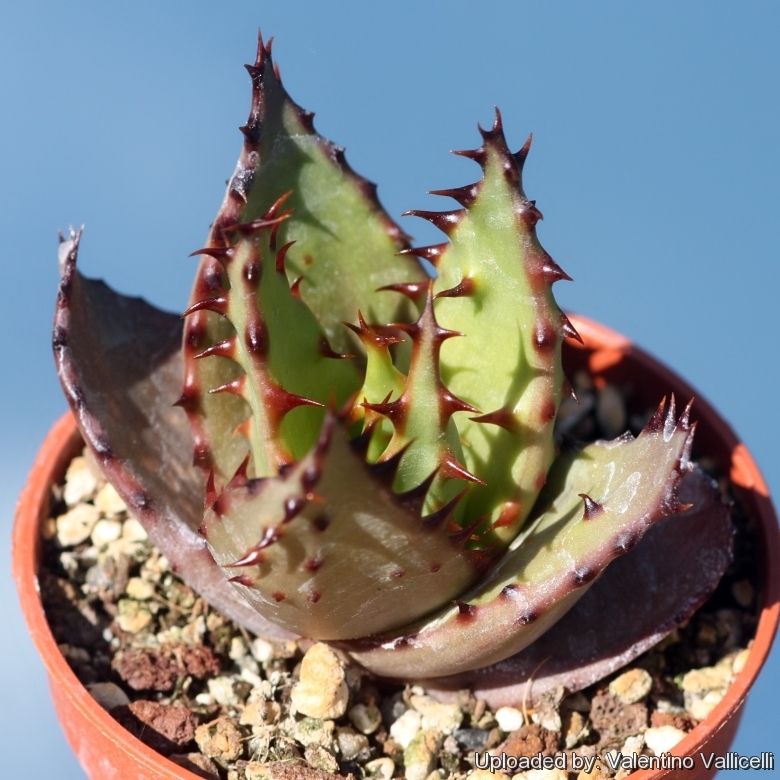




Your support is critical to our success.

Origin and Habitat: Tarkastad region (Tarkastad, Middelburg and Graaff-Reinet districts, possibly also in the Victoria West district), Eastern and Northern Cape, South Africa.
Aloe broomiiSN|31375]]SN|31375]] var. tarkaensis is a range-restricted subspecies (Extent of occurence 500 km²) and much rarer than the nominate variety. There are four or five known subpopulations (based on herbarium collections), but there may be others because it occurs in an area that is not intensively collected.
Habitat and Ecology: Nama Karoo. This species is not threatened and not declining.
Synonyms:
- Aloe broomii var. tarkaensis Reynolds
Aloe broomii var. tarkaensis Reynolds
J. S. African Bot. 2: 72. 1936
Accepted name in llifle Database:
Aloe broomii Schönland
Rec. Albany Mus. 2: 137 1907
ENGLISH: Mountain aloe, Snake aloe
AFRIKAANS (Afrikaans): Bergaalwyn, Bergaalwee, Slangaalwyn
Description: Aloe broomii var. tarkaensis is a robust, non-suckering, short-stemmed species distinguished from Aloe broomiiSN|12242]]SN|31375]] for its more luxuriant habit with broader, brownish or reddish leaves. This aloe holds a lot more leaves than most and has neat, upright, stiff leaves with very sharp, dark spines along the edges. The densely-leaved rosettes are somewhat reminiscent of Aloe polyphyllaSN|31375]]SN|12242]] in Lesotho. These plants develop a striking, simple, light green candle-like raceme (inflorescence) in which the bright small yellow-orange flowers open gradually along its length in ascending order. The inflorescence has flowers that are clearly visible because of the much shorter bracts, and the flowering time differs, being late-summer to early-autumn (February to early March). It is one of the nicest of all the aloe flower.
Subspecies, varieties, forms and cultivars of plants belonging to the Aloe broomii group
- Aloe broomii Schönland: Short-stemmed; leaves green with reddish brown teeth along the margins; inflorescence slender snake-like densely flowered, flowers completely hidden by longer bracts. Flowers September to October. Distribution: Cape Province, central Free State and southern Lesotho.
 Aloe broomii var. tarkaensis Reynolds: is more robust, with broader, brownish or reddish leaves. Buds and flowers are visible as the bracts being much shorter. Flowers February to early March. Distribution: south of Tarkastad, Eastern Cape.
Aloe broomii var. tarkaensis Reynolds: is more robust, with broader, brownish or reddish leaves. Buds and flowers are visible as the bracts being much shorter. Flowers February to early March. Distribution: south of Tarkastad, Eastern Cape.
Bibliography: Major references and further lectutres
1) Doreen Court “Succulent Flora of Southern Africa” CRC Press, 01 June 2000
2) Hans Bornman, David S. Hardy “Aloes of the South African veld” Voortrekkerpers, 1971
3) von Staden, L. Aloe broomii Schönland var. broomii. National Assessment: Red List of South African Plants version 2014.1. Accessed on 2015/07/28 2009.
4) Glen, H.F. and Hardy, D.S. “Aloaceae (First part): Aloe.” In: G. Germishuizen (ed). “Flora of Southern Africa” 5 Part 1, Fascicle 1:1-159. National Botanical Institute, Pretoria. 2000.
5) Raimondo, D., von Staden, L., Foden, W., Victor, J.E., Helme, N.A., Turner, R.C., Kamundi, D.A. and Manyama, P.A. “Red List of South African Plants.” Strelitzia 25. South African National Biodiversity Institute, Pretoria. 2009
6) Reynolds, G.W. “The Aloes of South Africa.” A.A. Balkema, Cape Town. 1969
7) Van Wyk, B.-E. and Smith, G. “Guide to the aloes of South Africa.” Briza Publications, Pretoria. 1996
Cultivation and Propagation: Aloe broomiiSN|31375]]SN|31375]] var. tarkaensis is one of the most ornamental aloes that is a fast-growing species that can reach full size in 5 or 6 years (if given proper growing conditions). It should be given a soil with a high lime content and grow best in those areas where there is frost in winter and the rainfall is not too high. Like most Aloe species, this plant is a water-wise plant that may be used in xeriscaping. It grows well in well-drained soil and flourishes in full sun. Mature plants are said to handle snow, although younger plants should be protected from hard freezes and overly wet conditions. The plant grows well in a pot, and can be moved indoors for the winter
Exposure: Outside, if the climate is cool it enjoys full sun. In warmer country, keep it cool by filtering the afternoon sun, and also avoid using a dark-coloured container.
Water: Aloe broomii is an ideal water-wise plant, especially in arid and semi-arid regions, but it comes from summer-rainfall areas, and appreciates consistent moisture during the summer months. As the plant gets established, reduce the amount of water and don't water at all during the rainy season. Established plants can take care of themselves as they store water in their leaves and are well adapted to an arid environment.
Pests and diseases: Aloe broomiiSN|31375]]SN|31375]] is susceptible to snout weevil and scale infestation, and to fungal infections. If in a pot try not to over water plants, tilt the pot so water never sits in the rosette. Water sitting in the rosette is the greatest cause of rotting these plants.
Propagation: This plant is propagated from seed. To grow the seeds keep them wet at all times do not let them dry out, 10-18 days and you will have success. Keep the soil wet for young ones until they are able to transplant into a larger container. When growing this aloes from seed there is one important consideration to bear in mind, the young plants are fairly slow growing and a systemic fungicide should be added to the watering as the they are very vulnerable.Take care not to over-water the seedlings, too much water may cause them to rot.
| Your Actions | |
|---|---|
| Back to Aloe index | |
| Back to Aloaceae index | |
 |
Back to Succulents Encyclopedia index |
Privacy stantement - Terms and conditions - How to cite - About us - Feedback - Donate



